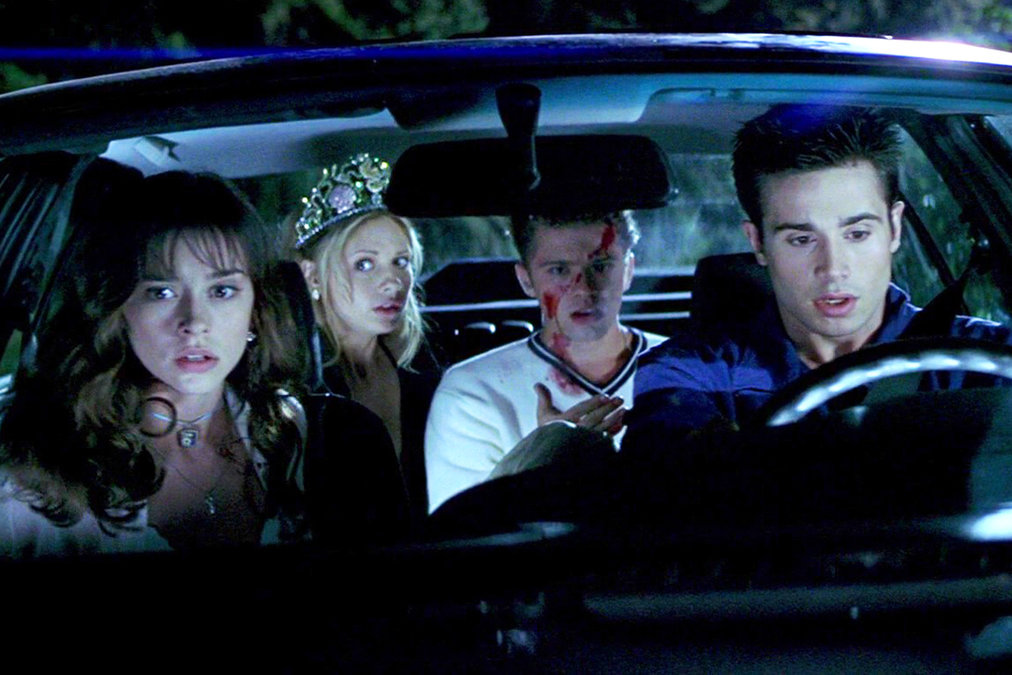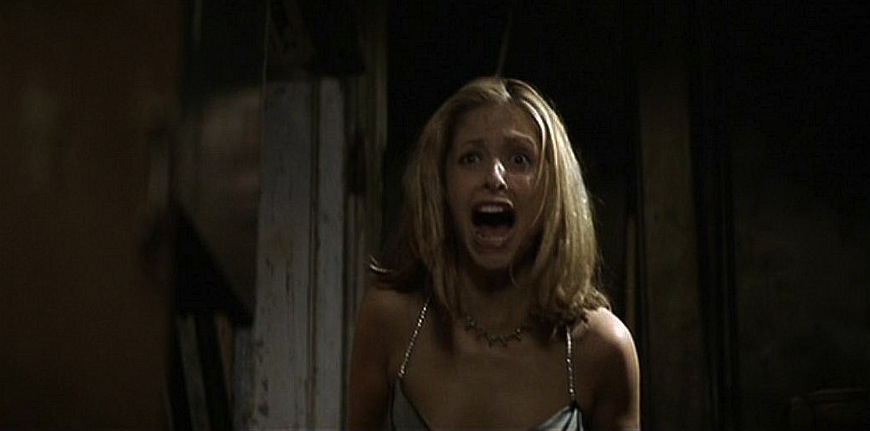By CWS
As a kid born in the late 80s, these were the first R rated movies I snuck into, the first VHS tapes I hid in my backpack and took to my friends' houses for sleepovers. These are the movies that provided my diabolical group with the creepy quotes we needed to prank call other kids in the neighborhood, as well as inspiration for how to look and act as cool as possible. These were the first movies I caught on late-night TV, awkwardly cut, with the swear words edited into their tamer versions, no longer matching the lips of their characters. Known to horror historians as the ‘Bronze Age,’ the late 90s and early 2000s created a handful of lasting slasher gems.
A big part of the charm of this era is that it's very self-aware. It was Scream that reignited the slasher genre in 1996, harkening back to classic 70s and 80s horror that saw teens murdered in Halloween, Nightmare on Elm Street, The Texas Chainsaw Massacre, and Friday the 13th. It was Scream that finally admitted what popular horror usually wouldn’t: this is scary, but this is also super dumb, mindlessly exploitive, and profoundly trashy, and this is what makes it so enjoyable to watch.
The brilliance lies in the genre beginning to understand itself, beginning to see its own repeating tropes and predictability, and playing off of it shamelessly and flamboyantly, but doing so while still producing quality plots and writing, rather than diving into the territory of complete parody. The 90s saw teen horror growing up, getting some therapy, and seeing itself clearly for the first time. It was getting a sense a humor about itself: instead of us laughing at bad horror, horror started laughing with us. All the while seeming as cool as an aloof teenager with a searing wit leaning back on a couch and drinking a beer.
There is something particularly satisfying about a horror movie starring teenagers or young adults, and there always has been. Kids are obsessed with teenagers, teenagers are obsessed with teenagers, and adults are obsessed with their own teenaged years. It is the territory of melodrama, where no matter what is happening in the world, your crush is at the center. There is an assumption of indestructibility; in the teenaged world, even though there is a serial killer picking off your schoolmates, the party must go on.
Urban Legend employs the classic teen story of the man in the backseat
And really, what’s more iconic in a horror movie than its raging party scene? Nineties horror loved a good indulgent teen or college party. Every time the montage began, when the liquor bottles came out, when the music got louder, when the clothes started coming off, that’s when you knew the first main character was going to die. As soon as their irresponsibility, their rebellion against the status quo began to show, the killer always struck.
Teen horror has much of its roots in urban legends, which in addition to highlighting society’s underlying fears, have always carried a coded warning about what behaviors will and will not be tolerated. Character Randy Meeks, a horror movie fanatic in Scream, called out these “rules” to surviving a horror movie: Never have sex, never drink or do drugs. Scream was calling out horror’s history of punishing what society deems unacceptable behavior, verging on the idea that one can “ask for” a bad outcome simply existing outside of the what is seen by the majority as appropriate and "good."
Randy Meeks describes the rules to surviving a horror movie in Scream
Teen horror unpacked these roots with 1998’s Urban Legend, bringing to life its underlying inspirations with a truly cool premise. Urban Legend is my favorite horror movie idea, with a serial killer reenacting popular urban legends while killing off young adults on a college campus, with one of the most surprising (and well-acted) villain reveals.
I Know What You Did Last Summer let teenagers know that they cannot run from the past, cannot hide the truth or it will come after them with a vengeance. You just can’t beat the cast of this movie; it is the most quintessential 90s cast possible. We’ve got horror darling Jennifer Love Hewitt, Buffy star Sarah Michelle Gellar, Freddie Prinze Jr., and Ryan Phillippe, all with that electric anxiety that can only come from a movie about an accidental murder, and trying keep that murder a secret (Search Party anyone?).
The villains of these films always had clear motives, based on revenge for a crime that went unpunished. The motiveless psychopaths of the 70s and 80s just never quite did it for me; I like a surprise reveal that makes all the mayhem make sense, even if it isn’t justifiable. Their franchises also continued to produce quality plots, instead of spinning into the ridiculous and jumping the shark ten times over, the way that the 70s and 80s films eventually would. All four Scream movies are excellent, especially my favorite, Scream 2 (bless the ever brilliant Laurie Metcalf), and even I Still Know What You Did Last Summer and Urban Legends: Final Cut, though not as strong as the consistently solid Scream franchise, continue to hold up.
Sarah Michelle Gellar owned the late 90s
And beyond pure slashers, there was another sub-genre that still held the same energy, but didn’t follow the serial killer format. The Faculty and the The Craft were two fantastic teen horror movies that used a supernatural spin on the classic slasher premise.
The Craft, which hit theaters a few months before Scream starred Fairuza Balk, an under-utilized gem of her time as well as brooding 90s dreamboat and current dreamboat of Riverdale fame, Skeet Ulrich. The Craft follows four friends who share a growing interest in witchcraft and find that their powers can combine to cast spells and alter their worlds, as well as the lives of their enemies and infatuations. Of course, in classic Dark Willow style, ultimate power always corrupts. This movie is a lot of fun, and a favorite feminist film that centers the experiences of women without making them the victims of a male killer.
The Faculty starred another late 90s icon Josh Harnett, Jordana Brewster, Elijah Wood, and the unrivaled Clea Duvall, and centered on a strange paranormal parasite that was infecting students and teachers and causing them to murder. This was a very hip film at the time, with a sharp wit and dark humor, and remains, despite some bad CGI, a great movie to watch with your friends.
Of course, the Wayan’s brothers’ horror spoof Scary Movie capped off this budding self-awareness in 2000, mainly sourcing its script from Scream and I Know What You Did Last Summer. It was a direct way of saying what horror films had been saying for the last several years, and of course, many lesser known films had been saying for decades; horror movies have always been funny, so why not make them funny on purpose, why not comment on horror with more and more horror (I'm fine with it).
I can't believe I saw this with my dad
The somewhat mild gore of these teen slashers felt more respectable than what was to come. They set the stage for films like my beloved 2000 Final Destination, which follows the supernatural slasher legacy of The Faculty and The Craft, while starting to enter the sphere known as splatter horror (Saw, Hostel) where graphic deaths reigned supreme. Though I enjoyed these movies for their creativity, I could never really get behind their gratuitous gore, and missed their smarter predecessors. A couple years later with the success of the honestly much more terrifying reboot of The Texas Chainsaw Massacre, the age of remakes was upon us.
My nostalgia definitely colors my love of late 90s horror, but even when I watch these films now, I am struck by how smart they are, how tongue-in-cheek. Their villains are human and because of that, they are more interesting and more destructible. I think of Ghost Face falling down the stairs in Scream: a slapstick monster that was no stronger than the average teenaged boy. More than anything else, these films are fun. They are aware of their exploitative nature and play with that, while never abandoning the urban-legend-formula that created the genre in the first place. Teen horror these days seems to be mainly a commentary on social media, with films like The Den, Friend Request, Unfriended, Tragedy Girls. Scream 4, which came out in 2011, was Wes Craven’s amazing last addition to the franchise before he passed away, and used social media as a huge part of its plot, setting the stage for years to come: an echo of the past come back to reassert itself more than ten years later in a newer form. I believe teen horror is here to stay, thank god, and I know it will continue to evolve as we evolve as a culture. Nonetheless, and it's cliche as hell: I miss the 90s and always will.





